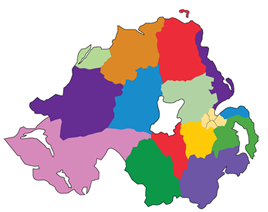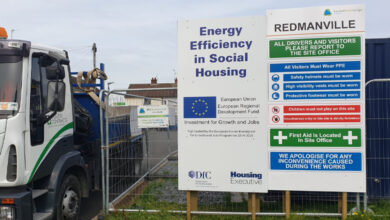Constituency boundary changes
 Constituencies are due to change shape as the Commons and Assembly get smaller.
Constituencies are due to change shape as the Commons and Assembly get smaller.
Northern Ireland’s political map is going back to the drawing board after Parliament approved plans to cut constituencies. The province currently has 18 MPs but this will drop to 16 by the next general election, due in 2015. Each constituency is also allowed to elect six MLAs so there will be 12 fewer MLAs at the next Assembly poll, held the same year. Stormont’s size will therefore fall from 108 to 96 MLAs.
The change has been introduced in the Parliamentary Voting System and Constituencies Act 2011, which aims to cut the House of Commons from 650 to 600 seats. The result of the AV referendum will not affect this number.
Based on the UK’s population, Northern Ireland should have 17 constituencies (a 2.9 per cent share), Wales 29, Scotland 50 and England 503, with one more up for grabs for any of the four countries.
The Government has conceded two seats to the Isle of Wight, one to the Scottish Western Isles, and one to Orkney and Shetland. This means the next House of Commons will be split as follows:
Each part of the UK has a boundary commission. The Northern Ireland version has three members: Mr Justice McLaughlin, Dick Mackenzie (a veteran of boundaries) and Dr William Smyth. Mackenzie and Smyth are both former civil servants. Its last review reported in 2009.
The commission expects few, if any, constituencies to stay the same and the smaller Belfast seats are most at risk. Proposals will be based on the size of the electorate on 1 December 2010.
At that point, Belfast East had the smallest population (60,050), followed closely by Belfast West (60,520) and Belfast South (60,726). The top three were Upper Bann (76,209), Newry and Armagh (75,856) and North Antrim (74,094).
Under the rules set down by Parliament, the new constituencies in Northern Ireland must have a minimum electorate of 70,583 and a maximum of 80,473.
The political consequences are unpredictable at this stage but there are some clear pros and cons to having fewer seats.
A move to 16 constituencies should also mean that voters are represented more fairly. An Upper Bann MLA currently represents 2,700 more voters than their counterpart in East Belfast. It will also save up to £390,000 in salaries and even more in expenses.
That said, the new areas will be larger than before and therefore less local. A smaller number of politicians will have to take on more constituency work. It would also be harder for candidates from minor parties to win seats. The Assembly’s size was originally set at 108 to give small parties, especially the loyalists, a chance. Sinn Féin and the PUP back that view.
Reviews must be strictly impartial. They can consider local geographical features, council boundaries, existing constituency boundaries and local ties that would be broken by any changes.
Provisional recommendations for the boundaries will be published by the end of 2011, followed by a 12-week public consultation. Public hearings will also take place. These proposals are normally revised and a further 8-week consultation then takes place. The final report will be presented to the Secretary of State for Northern Ireland before 1 October 2013.
In future, boundaries will be reviewed every five years. DUP MP Nigel Dodds has protested that this will cause confusion but the UK Government says it is necessary to keep up with voters moving between constituencies.
England: 502
Scotland: 52
Wales: 30
Northern Ireland: 16





